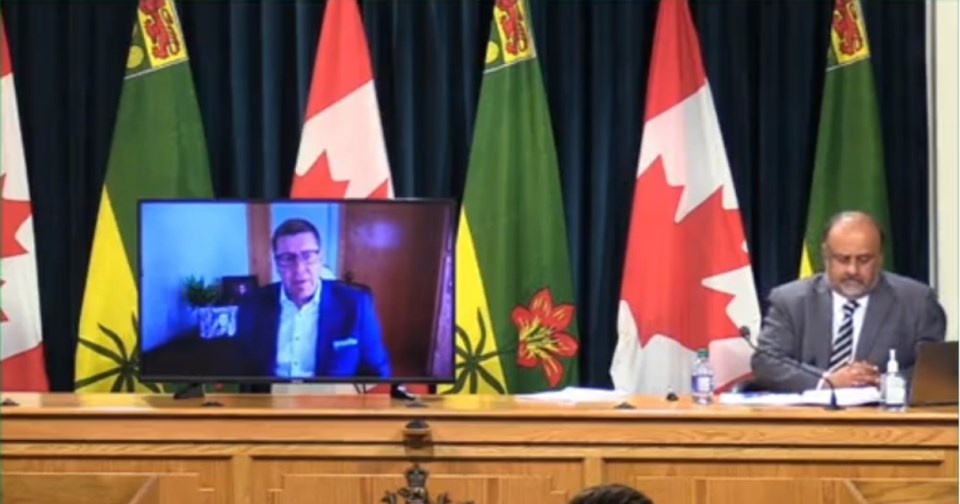New health measures aimed at reducing the spread of COVID-19 include suspension of team sports, and required use of masks in schools and workplaces.
The measures, which start Friday, Nov. 27, include:
Indoor Public Event Gatherings
- Indoor public gatherings will be limited to 30 people. This includes all types of social gatherings including weddings, funerals, as well as worship services. No food or drink may be present at these events.
- The maximum allowable gathering size for private gatherings in the home setting remains at five. If your immediate family is five or greater, you cannot have additional visitors.
- Gatherings of any size beyond one's immediate household are strongly discouraged at this time.
Mandatory Masking
- Mask use is now required in all common areas of businesses and workplaces, even if the public doesn't have access to them.
- All students, employees and visitors in schools and daycares are now required to wear a mask, except when they are eating or drinking. Children ages 0-2 years are exempt from wearing masks. Children ages 3-12 should wear a mask if they are able to.
-
All residents, employees and visitors in all common areas in provincial and municipal correctional facilities are required to wear masks.
Malls and Retail
- Retail businesses must enhance the expectation of mask use and mitigation measures (reduced traffic, directional flow signage, hand sanitizer, etc.) through signage and staff training.
- Large retail stores must limit their capacity to 50 per cent, or four square meters per person, whichever is less. Large retail locations are defined as retailers with a square footage larger than 20,000 square feet, and 50 per cent capacity is determined by half of the specified fire-code capacity.
Sports, Fitness and Dance
- All team/group sports, activities, games, competitions, recitals, practices, etc. are suspended until Dec. 17, including amateur and recreational leagues for all age groups. Examples include hockey, curling, racquet sports, cheerleading, dance practices in group setting, etc.
- Athletes and dancers 18 years of age and under may continue practicing, conditioning and skills training in groups of eight or fewer, abiding by the required mask use and at least three metres of physical distancing between participants at all times.
- Individual groups (of eight people or less) may not share a training/rehearsal surface or space with other groups at the same time. Coaches /trainers are not included in the training group numbers as long as they are masked and maintain a minimum physical distance of three metres.
- Fitness activities and group fitness classes in groups of eight or fewer continue to be permitted, for all ages. Mask use and at least three metres of physical distancing between participants must be maintained.
Restaurants and Licensed Establishments
- Restaurants, bars and nightclubs are now limited to four people seated at one table. They must have a distance of three meters between tables, unless they have barriers installed, in which case, a two meter distance between the tables would be allowed.
- Restaurants and licensed establishments must maintain guest/reservation information on all patrons.
Performance and Gaming Venues
- Capacity will be restricted to 30 people at all casinos, bingo halls, arenas, live performance venues and movie theaters, as well as any other facilities that currently have a capacity of up to 150 people.
- Where any of these facilities offer food or beverage service, they must keep the activity separate (i.e. cordoned off) from the food and beverage service. No food or drink may be in the activity area.
The measures will remain in effect until Thursday, Dec. 17, at which time they will be reviewed, revised or renewed.
“Our goal is to not shut down businesses services and activities that ultimately put people out of work or, at times, may threaten their mental health,” said Scott Moe, Saskatchewan’s premier.
“Our role is to find ways for those things to operate and to do so safely, so that people can continue to participate in athletics and continue to work, while at the same time continue to reduce the spread of COVID-19 in our communities.”
The premier said the province has chosen this course of action rather than a lockdown or three-week circuit breaker because there’s more understanding of the virus and how it spread compared to the spring.
“We know what we need to do to reduce the spread of this virus to keep ourselves and to keep others safe,” he said.
“The majority of Saskatchewan businesses and their employees in this province are operating safely day-to-day, so it would be terribly unfair, and it would have a huge negative impact, to close down all of those businesses and put thousands of Saskatchewan people out of work.”
Moe said he knows for many, including himself, that new restrictions are frustrating.
“I know we would all like to think if we just did this one more thing, or maybe one more rule or one more restriction that we could get this virus under control, but it doesn't work that way. There's no silver bullet to controlling COVID-19,” he said.
“There's no one practice or one restriction or one guideline that would prevent the spread of this virus. We have to do it all and we have to keep doing all of it all the time, each and every day.”



